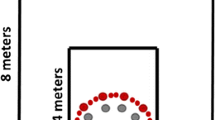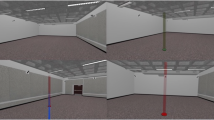Abstract
Two experiments investigated how self-motion cues and landmarks interact in determining a human’s position and heading estimations while driving in a large-scale virtual environment by controlling a gaming wheel and pedals. In an immersive virtual city, participants learned the locations of five buildings in the presence of two proximal towers and four distal scenes. Then participants drove two streets without viewing these buildings, towers, or scenes. When they finished driving, either one tower with displacement to the testing position or the scenes that had been rotated reappeared. Participants pointed in the directions of the five buildings. The least squares fitting method was used to calculate participants’ estimated positions and headings. The results showed that when the displaced proximal tower reappeared, participants used this tower to determine their positions, but used self-motion cues to determine their headings. When the rotated distal scenes reappeared, participants used these scenes to determine their headings. If they were instructed to continuously keep track of the origin of the path while driving, their position estimates followed self-motion cues, whereas if they were not given instructions, their position estimates were undetermined. These findings suggest that when people drive in a large-scale environment, relying on self-motion cues, path integration calculates headings continuously but calculates positions only when they are required; relying on the displaced proximal landmark or the rotated distal scenes, piloting selectively resets the position or heading representations produced by path integration.




Similar content being viewed by others
Notes
Note that we did not use the method developed in Mou and Zhang (2014), because this method requires people to indicate targets’ locations. In a large-scale environment, however, it is more realistic to point to the targets’ directions.
We used the fminsearch function in Matlab as the searching algorithm. Please find the example of the Matlab codes online (https://doi.org/10.7939/R3057D77Q).
Continuous updating or updating only when required of positions could not be diagnosed by the results in the no-piloting cue condition. Because there was no conflicting heading cue to interrupt position estimation from path integration at the end of the outbound path, participants could still use the moving distances and turning angle from self-motion cues to calculate their positions, even if they updated positions only when required.
References
Batschelet E (1981) Cirular statistics in biology. Academic Press, London
Benhamou S, Sauvé JP, Bovet P (1990) Spatial memory in large scale movements: efficiency and limitation of the egocentric coding process. J Theor Biol 145(1):1–12
Chen X, McNamara TP, Kelly JW, Wolbers T (2017) Cue combination in human spatial navigation. Cogn Psychol 95:105–144. https://doi.org/10.1016/j.cogpsych.2017.04.003
Cheng K, Spetch ML (1998) Mechanisms of landmark use in mammals and birds. In: Healy S (ed) Spatial representation in animals. Oxford University Press, Oxford, pp 1–17
Chrastil ER, Warren WH (2013) Active and passive spatial learning in human navigation: acquisition of survey knowledge. J Exp Psychol Learn Mem Cognit 39(5):1520–1537. https://doi.org/10.1037/a0032382
Etienne AS, Jeffery KJ (2004) Path integration in mammals. Hippocampus 14(2):180–192. https://doi.org/10.1002/Hipo.10173
Etienne AS, Teroni E, Hurni C, Portenier V (1990) The effect of a single light cue on homing behaviour of the golden hamster. Anim Behav 39(1):17–41
Etienne AS, Maurer R, Séguinot V (1996) Path integration in mammals and its interaction with visual landmarks. J Exp Biol 199(1):201–209
Etienne AS, Maurer R, Georgakopoulos J, Griffin A (1999) Dead reckoning (path integration), landmarks, and representation of space in a comparative perspective. In: Golledge RG (ed) Wayfinding behavior: cognitive mapping and other spatial processes. The Johns Hopkins University Press, Baltimore, pp 197–228
Etienne AS, Maurer R, Boulens V, Levy A, Rowe T (2004) Resetting the path integrator: a basic condition for route-based navigation. J Exp Biol 207(9):1491–1508
Farrell MJ, Robertson IH (1998) Mental rotation and the automatic updating of body-centered spatial relationships. J Exp Psychol Learn Mem Cognit 24:227–233
Foo P, Warren WH, Duchon A, Tarr MJ (2005) Do humans integrate routes into a cognitive map? Map-versus landmark-based navigation of novel shortcuts. J Exp Psychol Learn Mem Cognit 31:195–215. https://doi.org/10.1037/0278-7393.31.2.195
Fujita N, Klatzky RL, Loomis JM, Golledge RG (1993) The encoding-error model of pathway completion without vision. Geogr Anal 25(4):295–314. https://doi.org/10.1111/j.1538-4632.1993.tb00300.x
Gallistel CR (1990) The organization of learning. MIT Press, Cambridge
Gallistel CR, Matzel LD (2013) The neuroscience of learning: beyond the Hebbian synapse. Annu Rev Psychol 64:169–200
He Q, McNamara TP (2017) Spatial updating strategy affects the reference frame in path integration. Psychon Bull Rev. https://doi.org/10.3758/s13423-017-1307-7
Ishikawa T, Montello DR (2006) Spatial knowledge acquisition from direct experience in the environment: individual differences in the development of metric knowledge and the integration of separately learned places. Cogn Psychol 52(2):93–129. https://doi.org/10.1016/j.cogpsych.2005.08.003
Kearns MJ, Warren WH, Duchon AP, Tarr MJ (2002) Path integration from optic flow and body senses in a homing task. Perception 31(3):349–374. https://doi.org/10.1068/p3311
Kelly JW, McNamara TP, Bodenheimer B, Carr TH, Rieser JJ (2008) The shape of human navigation: how environmental geometry is used in maintenance of spatial orientation. Cognition 109(2):281–286. https://doi.org/10.1016/j.cognition.2008.09.001
Klatzky RL, Loomis JM, Beall AC, Chance SS, Golledge RG (1998) Spatial updating of self-position and orientation during real, imagined, and virtual locomotion. Psychol Sci 9(4):293–298. https://doi.org/10.1111/1467-9280.00058
Loomis JM, Klatzky RL, Golledge RG, Cicinelli JG, Pellegrino JW, Fry PA (1993) Nonvisual navigation by blind and sighted: assessment of path integration ability. J Exp Psychol Gen 122(1):73–91
Loomis JM, Klatzky RL, Golledge RG, Philbeck JW (1999) Human navigation by path integration. In: Golledge RG (ed) Wayfinding behavior: cognitive mapping and other spatial processes, Johns Hopkins, Baltimore, pp 125–151
Maurer R, Séguinot V (1995) What is modelling for? A critical review of the models of path integration. J Theor Biol 175(4):457–475
May M, Klatzky RL (2000) Path integration while ignoring irrelevant movement. J Exp Psychol Learn Mem Cogn 26:169–186. https://doi.org/10.1037/0278-7393.26.1.169
Mittelstaedt ML, Mittelstaedt H (1980) Homing by path integration in a mammal. Naturwissenschaften 67(11):566–567
Mittelstaedt ML, Mittelstaedt H (2001) Idiothetic navigation in humans: estimation of path length. Exp Brain Res 139(3):318–332. https://doi.org/10.1007/s002210100735
Montello DR (1993) Scale and multiple psychologies of space. In: Spatial information theory: a theoretical basis for GIS. Springer, Berlin, pp 312–321
Mou W, Zhang L (2014) Dissociating position and heading estimation: rotated visual orientation cues perceived after walking reset headings but not positions. Cognition 133:553–571. https://doi.org/10.1016/j.cognition.2014.08.010
Nardini M, Jones P, Bedford R, Braddick O (2008) Development of cue integration in human navigation. Curr Biol 18(9):689–693. https://doi.org/10.1016/j.cub.2008.04.021
Riecke BE, Cunningham DW, Bülthoff HH (2007) Spatial updating in virtual reality: the sufficiency of visual information. Psychol Res 71(3):298–313. https://doi.org/10.1007/s00426-006-0085-z
Rieser JJ (1989) Access to knowledge of spatial structure at novel points of observation. J Exp Psychol Learn Mem Cogn 15:1157–1165
Ruddle RA, Lessels S (2009) The benefits of using a walking interface to navigate virtual environments. ACM Trans Comput Hum Interact TOCHI 16(1):1–18. https://doi.org/10.1145/1502800.1502805
Tcheang L, Bulthoff HH, Burgess N (2011) Visual influence on path integration in darkness indicates a multimodal representation of large-scale space. Proc Natl Acad Sci USA 108(3):1152–1157. https://doi.org/10.1073/pnas.1011843108
Thompson WB, Willemsen P, Gooch AA, Creem-Regehr SH, Loomis JM, Beall AC (2004) Does the quality of the computer graphics matter when judging distances in visually immersive environments? Presence Teleoper Virtual Environ 13(5):560–571
Viaud-Delmon I, Ivanenko YP, Berthoz A, Jouvent R (1998) Sex, lies and virtual reality. Nat Neurosci 1(1):15
Waller D, Loomis JM, Steck SD (2003) Inertial cues do not enhance knowledge of environmental layout. Psychon Bull Rev 10:987–993
Waller D, Loomis JM, Haun DBM (2004) Body-based senses enhance knowledge of directions in large-scale environments. Psychon Bull Rev 11:157–163
Warren WH, Rothman DB, Schnapp BH, Ericson JD (2017) Wormholes in virtual space: from cognitive maps to cognitive graphs. Cognition 166:152–163. https://doi.org/10.1016/j.cognition.2017.05.020
Wehner R, Michel B, Antonsen P (1996) Visual navigation in insects: coupling of egocentric and geocentric information. J Exp Biol 199:129–140
Wiener JM, Berthoz A, Wolbers T (2011) Dissociable cognitive mechanisms underlying human path integration. Exp Brain Res 208(1):61–71. https://doi.org/10.1007/s00221-010-2460-7
Yerramsetti A, Marchette SA, Shelton AL (2013) Accessibility versus accuracy in retrieving spatial memory: evidence for suboptimal assumed headings. J Exp Psychol Learn Mem Cogn 39(4):1106. https://doi.org/10.1037/a0030905
Zhang L, Mou W (2017) Piloting systems reset path integration systems during position estimation. J Exp Psychol Learn Mem Cogn 43(3):472–491. https://doi.org/10.1037/xlm0000324
Zhao M, Warren WH (2015) How you get there from here: interaction of visual landmarks and path integration in human navigation. Psychol Sci 26(6):915–924. https://doi.org/10.1177/09567976155749
Acknowledgements
This work was funded by the Natural Sciences and Engineering Research Council of Canada (NSERC), Canada to Weimin Mou.
Author information
Authors and Affiliations
Corresponding authors
Appendix
Appendix
Derivation of homing error = position error – heading error (i.e., b_ PO′ – b_PO = (b_OP′ − b_OP) – (h’ − h)) (see Fig. 5).
A hypothetic participant while standing at the testing position (P) with the testing heading (h) points to the location of the origin (O). Suppose that the judged location of O is O′. The angular error of homing is b_ PO′ – b_PO. b_AB refers to a bearing from positions A to B relative to an horizontal allocentric reference direction in the environment. Suppose that this participant’s estimates of his or her testing position and heading are P′ and h′. The angular error of heading is h′ – h. Both h and h′ are specified by the angular distance from the allocentric reference direction. The angular error of position is b_OP′ − b_OP. As derived in the “Appendix”, homing error = position error – heading error. Position errors and heading errors cannot be dissociated with the measured homing errors. If this participant also learns an addition location X and then replaces X in the position of X′, then position errors can be measured by (b_OX – b_PO) – (b_O′X′– b_PO′) [see Mou and Zhang (2014) for derivation] and heading errors can also be measured given the measured position errors and homing errors (heading error = position error – homing error)
We assume that this participant uses the represented spatial relations between the origin (O), the estimated testing position (P′), and the estimated testing heading (h′) in his or her spatial memory to judge the relations between replaced location of the origin (O′), the testing position (P), and the testing heading (h) during response. Hence the relations between the elements in the memory (O, P′, h′) should be the same as the relations between the elements in the response (O′, P, h).
We obtain
All headings (h and h′) and bearings (i.e., b_AB) are defined as the angular distance from a fixed allocentric direction in the environment. We further define the clockwise direction as the positive direction to specify an angular distance. As signed angles belong to real numbers, all the mathematical principles for read numbers should be applied to headings and bearings.
Equation 1 can be rewritten as
Therefore,
We obtain
Because b_AB = b_BA − 180, we rewrite Eq. 3 as
We obtain
b_PO′ − b_PO = b_OP′ − b_OP – (h′ − h) or homing error = position error – heading error.
Rights and permissions
About this article
Cite this article
Zhang, L., Mou, W. Selective resetting position and heading estimations while driving in a large-scale immersive virtual environment. Exp Brain Res 237, 335–350 (2019). https://doi.org/10.1007/s00221-018-5417-x
Received:
Accepted:
Published:
Issue Date:
DOI: https://doi.org/10.1007/s00221-018-5417-x





